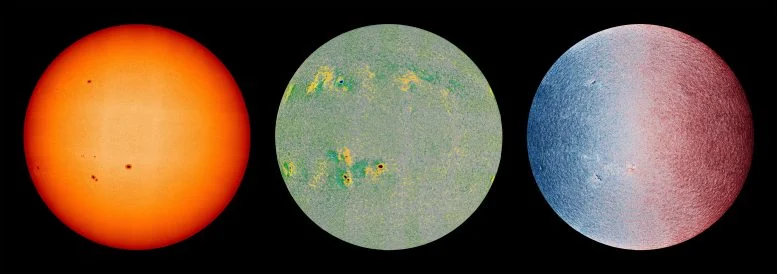
By European Space Agency (ESA) December 24, 2024
Collected at: https://scitechdaily.com/solar-orbiters-stunning-new-views-of-the-sun-reveal-hidden-dynamics/
The Solar Orbiter mission has produced unprecedented high-resolution images of the Sun, showcasing the complex interplay of its magnetic fields and plasma movements. These images, which include detailed views of sunspots and the corona, enhance our understanding of solar phenomena.
Take a closer look at four stunning new images of the Sun captured by Solar Orbiter on March 22, 2023. These images, taken using the spacecraft’s PHI (Polarimetric and Helioseismic Imager) and EUI (Extreme Ultraviolet Imager) instruments, provide unprecedented detail. The PHI images offer the sharpest-ever full views of the Sun’s visible surface, mapping its intricate magnetic fields and surface movements. In contrast, the EUI image reveals the glowing outer atmosphere, known as the corona.
Unveiling the Sun’s Dynamic Nature
The Sun, the most dynamic and complex object in our Solar System, has never been seen in such detail. The ESA-led Solar Orbiter mission employs six advanced imaging instruments to study the Sun, peeling back its layers to expose its multifaceted nature.
With these latest observations, Solar Orbiter delivers its most detailed images yet of the Sun’s visible surface, or photosphere. The PHI instrument not only captures visible light images but also measures the magnetic field’s direction and tracks the speed and motion of surface material. These insights offer an extraordinary glimpse into the Sun’s ever-changing behavior.

PHI’s measurements of the photosphere can be directly compared to a new image of the Sun’s outer atmosphere (the corona) assembled from high-resolution images taken by the Extreme Ultraviolet Imager (EUI) instrument on the same day in March 2023. EUI images the Sun in ultraviolet light.
“The Sun’s magnetic field is key to understanding the dynamic nature of our home star from the smallest to the largest scales. These new high-resolution maps from Solar Orbiter’s PHI instrument show the beauty of the Sun’s surface magnetic field and flows in great detail. At the same time, they are crucial for inferring the magnetic field in the Sun’s hot corona, which our EUI instrument is imaging,” notes Daniel Müller, Solar Orbiter’s Project Scientist.
This release follows on from one two years ago, when the mission released full images of the Sun taken by the spacecraft’s EUI and Spectral Imaging of the Coronal Environment (SPICE) instruments on March 7, 2022.

High-Resolution Sunspot Analysis
Zooming into PHI’s detailed visible light image (above) reveals the Sun’s ‘surface’ for what it is: glowing, hot plasma (charged gas) that is constantly moving. Almost all radiation from the Sun is emitted from this layer, which has a temperature between 4500 and 6000 °C. Beneath it, the hot, dense plasma is churned around in the ‘convection zone’ of the Sun, not unlike magma in Earth’s mantle. As a result of this movement, the Sun’s surface takes on a grainy appearance.
However, the most striking features in the images are the sunspots. In the visible light image, these look like dark spots, or holes, in the otherwise smooth surface. Sunspots are colder than their surroundings, and therefore give off less light.

The Movement and Structure of Solar Plasma
PHI’s magnetic map (image above), or ‘magnetogram’, shows that the Sun’s magnetic field is concentrated in the sunspot regions. It either points outward (red) or inward (blue) wherever the sunspots lie. The strong magnetic field explains why plasma inside sunspots is colder. Normally, convection moves heat from inside the Sun to its surface, but this is disrupted by charged particles being forced to follow the dense magnetic field lines in and around the sunspots.
The speed and direction of movement of material at the Sun’s surface can be seen in PHI’s velocity map (image below), also known as a ‘tachogram’. Blue shows movement towards the spacecraft, while red indicates movement away from the spacecraft. This map shows that while the plasma on the surface of the Sun generally rotates with the Sun’s overall spin around its axis, it is pushed outward around the sunspots.

The Solar Corona: A Hot Plasma Show
Finally, EUI’s image of the Sun’s corona (below) shows what happens above the photosphere. Above the active sunspot regions, glowing plasma is seen protruding out. The million-degree plasma follows magnetic field lines sticking out from the Sun, often connecting neighboring sunspots.

Technical Achievements in Solar Imaging
The images were taken when Solar Orbiter was less than 74 million kilometers from the Sun. Being so close to the Sun meant each high-resolution image taken by PHI and EUI only covers a small portion of the Sun. After each individual image was taken, the spacecraft needed to be tilted and rotated until each part of the Sun’s face was imaged.
To obtain the full-disc images presented here, all images were stitched together like a mosaic. The PHI and the EUI mosaic are composed of 25 images each, captured over a period of more than four hours. The Sun’s disc has a diameter of almost 8000 pixels in the full mosaics, revealing an incredible amount of detail.
The image processing required to obtain the PHI mosaics was new and difficult. Now that it has been done once, processing the data and assembling mosaics will go faster in the future. The PHI team expects to be able to provide such high-resolution mosaics twice a year.
Collaborative Space Exploration
Solar Orbiter is a space mission of international collaboration between ESA and NASA, operated by ESA.

Leave a Reply